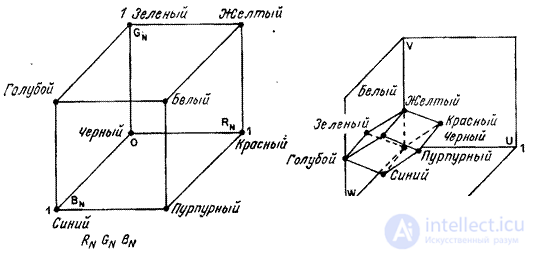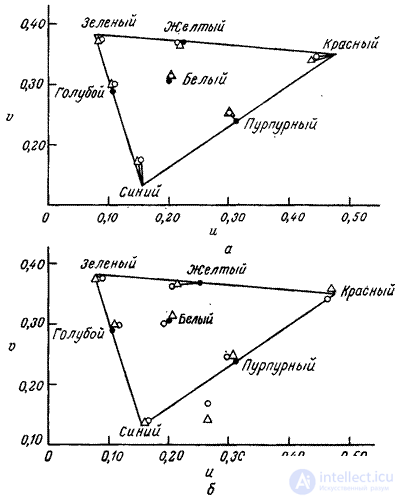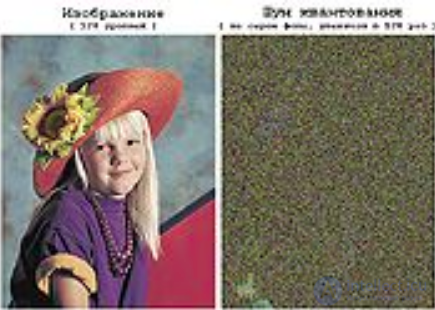Lecture
A color image can be described using red, green, and blue color coordinates or an arbitrary (linear or non-linear) reversible function of these quantities. If the red, green and blue coordinates of the color are quantized separately, then the number and location of the quantization levels are selected according to the same general rules as in the quantization of monochrome images. The eye responds to the intensity of light non-linearly, and therefore the quality of the quantized color image is subjectively evaluated higher if the color coordinates are subjected to non-linear transformation, which compresses their dynamic range, before quantization. It is known that the eye is most sensitive to changes in brightness in the blue region of the spectrum, moderately sensitive to such changes in the green region and least sensitive in the red region. Given this, it is possible to obtain a more efficient distribution of quantization levels than a uniform one.

Fig. 6.5.1. Quantization of color images.
In fig. 6.5.1 shows a generalized block diagram of a quantization system for color images. Three color coordinates  ,
,  ,
,  describing the original image is converted into three components of the vector
describing the original image is converted into three components of the vector  ,
,  ,
,  which go to the quantizer. Then quantized components
which go to the quantizer. Then quantized components  ,
,  and
and  converted back to the original coordinate system; the result is three coordinates.
converted back to the original coordinate system; the result is three coordinates.  ,
,  ,
,  . A quantizer (Fig. 6.5.2) essentially divides the quantization cells into a color space that has the coordinates
. A quantizer (Fig. 6.5.2) essentially divides the quantization cells into a color space that has the coordinates  ,
,  and
and  , and sets in correspondence to all color signals that fall in the cell, the same value. For greater efficiency, three color components should be quantized.
, and sets in correspondence to all color signals that fall in the cell, the same value. For greater efficiency, three color components should be quantized.  ,
,  and
and  jointly. However, for technical reasons, it is often necessary to quantize the color components independently. In this case, the color body is in a rectangular parallelepiped, which is divided into rectangular quantization cells.
jointly. However, for technical reasons, it is often necessary to quantize the color components independently. In this case, the color body is in a rectangular parallelepiped, which is divided into rectangular quantization cells.
If the coordinates of the color are converted to some other coordinate system, then immediately there are difficulties. Consider, for example, the quantization of color coordinates in the system  .
.

Fig. 6.5.2. Body of reproduced colors in coordinate systems  and
and  .
.
In fig. 6.5.2 shows the body of reproducible colors for the system.  presented in the form of a cube, and also given the form of this cube after transforming it into a coordinate system
presented in the form of a cube, and also given the form of this cube after transforming it into a coordinate system  . You may notice that the cube
. You may notice that the cube  turns into parallelepiped. If the coordinates
turns into parallelepiped. If the coordinates  ,
,  ,
,  quantized independently of each other, and the quantization range of each of them covers the entire interval from the minimum to maximum values, then many quantization cells fall into the region of unrepeatable colors and therefore are useless. It would be desirable to place all the quantization cells inside the parallelepiped of reproducible colors, but, as a rule, such an operation is difficult to implement in practice.
quantized independently of each other, and the quantization range of each of them covers the entire interval from the minimum to maximum values, then many quantization cells fall into the region of unrepeatable colors and therefore are useless. It would be desirable to place all the quantization cells inside the parallelepiped of reproducible colors, but, as a rule, such an operation is difficult to implement in practice.
Suppose to simplify the analysis that each component is quantized uniformly on  levels, and
levels, and  denotes the number of bits allocated to quantizing the component.
denotes the number of bits allocated to quantizing the component.  . The total number of such digits is fixed and equal to
. The total number of such digits is fixed and equal to
 . (6.5.1)
. (6.5.1)
Assume that  denotes the top, a
denotes the top, a  - the lower limit of the range of values of the component
- the lower limit of the range of values of the component  . Then the sizes of the quantization cells are
. Then the sizes of the quantization cells are
 . (6.5.2)
. (6.5.2)
All colors whose color component  gets into the same cell, during quantization will be replaced with one color with a quantized value
gets into the same cell, during quantization will be replaced with one color with a quantized value  this component. The quantization error for each component is equal to
this component. The quantization error for each component is equal to
 . (6.5.3)
. (6.5.3)

Fig. 6.5.3. Color shift with uniform quantization of the “Portrait” image [15]: a - color shift when quantized in the coordinate system  ; b - color shift when quantized in the system
; b - color shift when quantized in the system  .
.  4 digits for each of the three coordinates,
4 digits for each of the three coordinates,  5, 4, 3 digits for the corresponding coordinates.
5, 4, 3 digits for the corresponding coordinates.
Then the coordinate of the quantized color
 , (6.5.4)
, (6.5.4)
and  . It should be noted that the values
. It should be noted that the values  will always be inside the smallest cube surrounding the color body for a given color coordinate system.
will always be inside the smallest cube surrounding the color body for a given color coordinate system.
In fig. 6.5.3 shows the displacement of various colors when quantizing in the coordinate systems  and
and  [15].
[15].
Jane and Pratt [15] considered the question of the optimal distribution of threshold levels when quantizing color images, which allows reducing the color distance between the original color and its quantized value to a possible limit. It was found that quantization in the coordinate system  gives better results than other common color coordinate systems. This is because in the system
gives better results than other common color coordinate systems. This is because in the system  all quantization cells are effectively used, while in other systems many cells are unoccupied. The latter seems to be more significant than the metric heterogeneity of the color space.
all quantization cells are effectively used, while in other systems many cells are unoccupied. The latter seems to be more significant than the metric heterogeneity of the color space.  .
.


Рис.4, 5. Квантование.и шум квантования цветного изображения
Comments
To leave a comment
Digital image processing
Terms: Digital image processing